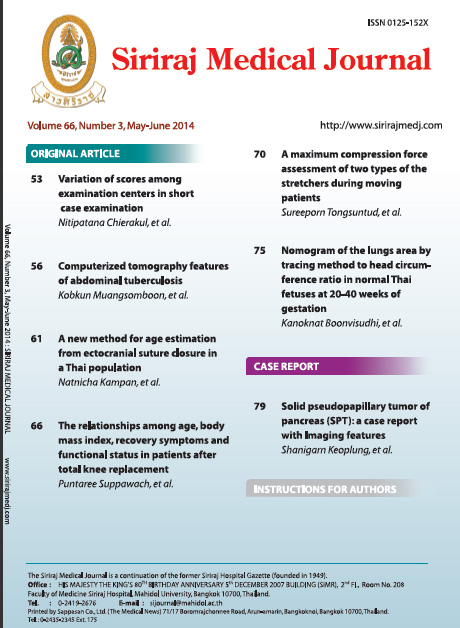Nomogram of the Lungs Area by Tracing Method to Head Circumference Ratio in Normal Thai Fetuses at 20-40 Weeks of Gestation
Abstract
Objective: To establish the reference intervals with gestation for the area of the lungs to head circumference ratio (LHR) by tracing method in normal Thai fetuses at 20-40 weeks of gestation.
Methods: This was a prospective longitudinal descriptive study of 60 normal singleton pregnancies at 20-40 weeks of gesta- tion. Right and left lung areas were obtained by manual tracing of the borders of the lungs technique at four-chamber view level. The examination was repeated every 4 weeks. Inter-observer and intra-observer reliabilities were assessed and the results showed very good correlation.
Results: The mean left lung area increased with gestational age from 246 mm2 at 20 weeks to 646 mm2 at 35 weeks and then slightly decreased to 622 mm2 at 40 weeks. The mean right lung area increased from 354 mm2 at 20 weeks to 938 mm2 at 35 weeks and then slightly decreased to 795 mm2 at 40 weeks. Accordingly, the left LHR increased with gestational age from 1.38 at 20 weeks to 2.02 at 34 weeks and slightly decreased to 1.80 at 40 weeks. The right LHR increased from 1.98 at 20 weeks to 2.93 at 34 weeks and slightly decreased to 2.30 at 40 weeks.
Conclusion: The reference intervals with gestation for the lungs’ area to head circumference ratio (LHR) by tracing method in normal Thai fetuses at 20-40 weeks of gestation was established. The left and right LHR increased with gestational age from 20-34 weeks and then slightly decreased after that.
Keywords: Congenital diaphragmatic hernia, lungs’ area, lung-to-head ratio, pulmonary hypoplasia, ultrasonography
Siriraj Med J 2014;66:75-78
Downloads
Published
How to Cite
Issue
Section
License
Authors who publish with this journal agree to the following conditions:
Copyright Transfer
In submitting a manuscript, the authors acknowledge that the work will become the copyrighted property of Siriraj Medical Journal upon publication.
License
Articles are licensed under a Creative Commons Attribution-NonCommercial-NoDerivatives 4.0 International License (CC BY-NC-ND 4.0). This license allows for the sharing of the work for non-commercial purposes with proper attribution to the authors and the journal. However, it does not permit modifications or the creation of derivative works.
Sharing and Access
Authors are encouraged to share their article on their personal or institutional websites and through other non-commercial platforms. Doing so can increase readership and citations.










